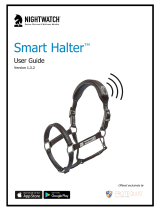
5. How to attach the T56H trans-
mitter on the horse
First of all, identify the 2 electrode pads on
each side of the transmitter. The electrode
with velcro on the back is the positive
electrode and logically the other electrode is
the negative electrode. In the middle, you’ll find
the WearLink transmitter pocket.
The transmitter picks up very small electrical
impulses emitted by the heart and for the
transmitter to read the heart rate properly, we
need to insure a good contact to the horse’s
skin. Make sure you wet the electrodes
properly, the integrated sponge will keep up
some moisture, but you still need to wet to
horse’s coat, especially as your horse is not yet
sweating. If your horse has a thick winter coat,
you can shave the spot where you will place the
electrodes, this will greatly improve the heart
rate signal quality.
Place the positive electrode on the left or right side of
the withers under the saddle. Ensure that the elec-
trode is flat against the horse’s skin. The rider’s
weight will keep the electrode in place.
Attach the WearLink transmitter into the transmiter
pocket and close it. This pocket protects your trans-
mitter from shocks and scratches and prevents it from
falling off transmitter.
Attach the transmitter to the saddle with one of the
rubber straps
Attach the negative electrode to the girth using a
rubber strap and tighten the girth. If you are riding with
a loose girth, you might want to place a sponge be-
hind the negative electrode to insure contact with the
skin.
Using contact gel on the elec-
trodes of the T56H transmitter
is highly recommended. It
ensures a better detection of
the horse’s heart rate.
The hypo-allergenic and chlo-
ride-free electrode gels ensure
a better conductivity. Non-
thinning formula will not break
down or irritate after lengthy
contact.
Here is an example of conduc-
tive gel recommended by the
biggest electrodes manufac-
turers, to be used on multifunc-
tional electrodes.
Frequently Asked Questions
The Heart Rate Seems to be Wrong?
• Make sure that the positions of the electrodes are
correct.
• Make sure that the horse’s coat under the elec-
trodes is thoroughly moistened.
• Accumulated sweat and dirt may interfere with the
measurement of the signal from the heart to the
transmitter. Check if the electrodes need cleaning.
• Make sure that the transmitter is firmly attached to
the electrode set.
• In some cases, (at about 120 bpm) a double pulse
can occur at each heart beat (R + T waves). This
problem disappears when the intensity increases.
• A lot of use can cause oxidization of the elec-
trodes. Wash the electrodes with water and soap
solution, and then dry them carefully after each
use. If you see the silver colored fibers on the
electrode fading, your textile electrode set needs
to be replaced. Ask your retailer for part #
93037106 Polar Equine Electrodes for WearLink
transmitter.
The Watch Receiver Display is Blank or
Fading?
• Have the battery checked by the appointed Polar
Distributors - Polar authorized service center.
Care and Maintenance of the Transmitter
• The Polar equine T56H transmitter is active only
when the electrodes are in contact with the
horse’s coat and the transmitter attached to the
electrode set.
• Sweat and moisture can keep the electrodes wet
and the transmitter activated, which shortens the
battery life. Therefore, clean the electrodes and
let them dry after use and detach the transmitter
from the electrode set.
• Make sure that the electrodes (conductive) are
not in contact.
• Dirt on the electrodes weakens the contact be-
tween a horse’s body and the electrodes. To en-
sure good operation, wash the electrodes regular-
ly with a mild soap and water solution. However,
never use alcohol or any abrasives such as
steel wool or cleaning chemicals. They will
cause permanent damage to the electrodes.
• The material used for electrodes and strap is very
soft and comfortable; take care of these parts to
prevent any damage. Electrodes should be re-
placed by an authorized Polar service personnel.
• For details, contact your dealer or distributor.
6. Starting training
You are now ready to start. Starting from the
time display, press OK twice.
The stopwatch starts, a heart symbol blinks and
the horse’s heart rate is displayed in the bottom
of the screen. From now on, the RS800CX is
recording your exercise.
Each display shows 3 rows of data and is named
after the bottom row.
To check the data you are most interested in,
change display by pressing UP or DOWN. (6 dif-
ferent displays are set by default but can be cus-
tomized – see user manual)
You can also zoom on a data to make it larger on
the display.
Press and hold UP for 2 seconds to zoom in the
data of the top row, or DOWN for 2 seconds to
zoom in the data of the bottom row. Press and
hold the same button for 2 seconds to zoom out.
To stop the exercise, press STOP twice. The
RS800CX returns to time display.
All the data has been recorded and can be re-
trieved in the file. To access the file, press UP
once from time display and then validate by
pressing OK.
For more detailed information on how the
RS800CX G3 Equine works, please check the
user manual included in the box.
For more tips of use, training advices and more in-
formation on Polar Equine products, visit
www.polar-equine.com
For more information on Polar products, visit
www.polar.fi
Enjoy your ride!



